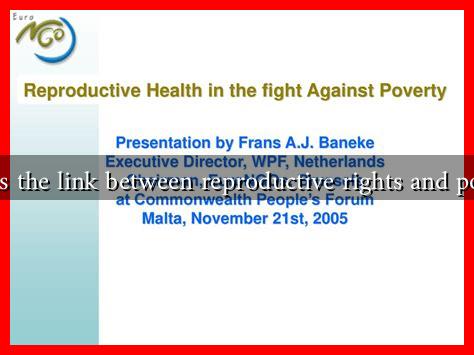-
Table of Contents
The Link Between Reproductive Rights and Poverty
Reproductive rights are fundamental human rights that encompass the ability to make informed choices about one’s reproductive health, including access to contraception, family planning, and safe abortion services. The intersection of reproductive rights and poverty is a critical area of study, as the two are deeply intertwined. This article explores how reproductive rights impact poverty levels and vice versa, highlighting the importance of addressing both issues to foster social and economic development.
Understanding Reproductive Rights
Reproductive rights refer to the legal rights and freedoms relating to reproduction and reproductive health. These rights include:
- The right to access contraception and family planning services.
- The right to receive comprehensive sex education.
- The right to safe and legal abortion services.
- The right to access prenatal and postnatal care.
When individuals have control over their reproductive choices, they can make informed decisions that significantly affect their economic stability and overall well-being.
The Cycle of Poverty and Limited Reproductive Rights
Poverty is often both a cause and a consequence of limited reproductive rights. Here are some ways in which these two issues are interconnected:
- Unplanned Pregnancies: Lack of access to contraception leads to unplanned pregnancies, which can strain financial resources. Women in poverty are often unable to afford the costs associated with raising a child, leading to a cycle of poverty.
- Education Disruption: Unplanned pregnancies can disrupt education for young women, limiting their future job prospects and earning potential. According to the World Bank, girls who complete secondary education are more likely to escape poverty.
- Health Risks: Women in low-income communities often lack access to quality healthcare, increasing the risks associated with pregnancy and childbirth. The World Health Organization (WHO) reports that maternal mortality rates are significantly higher in impoverished regions.
- Economic Burden: Families facing economic hardship may struggle to provide for additional children, leading to increased financial stress and potential reliance on social welfare programs.
Case Studies and Statistics
Several studies illustrate the link between reproductive rights and poverty:
- A study by the Guttmacher Institute found that providing women with access to contraceptive services could reduce the number of unintended pregnancies by 70%, significantly alleviating poverty levels.
- In sub-Saharan Africa, where reproductive health services are often limited, the poverty rate is approximately 41%, compared to 14% in regions with better access to reproductive healthcare.
- The United Nations Population Fund (UNFPA) reports that every additional year of education for girls can increase their future earnings by up to 20%, emphasizing the importance of reproductive rights in educational attainment.
Global Efforts to Address the Issue
Recognizing the link between reproductive rights and poverty, various global initiatives aim to improve access to reproductive health services:
- International Conference on Population and Development (ICPD): This conference emphasized the importance of reproductive rights in achieving sustainable development goals.
- Family Planning 2020 (FP2020): This initiative aims to provide 120 million more women and girls in the world’s poorest countries with access to contraceptives by 2020.
- UN Sustainable Development Goals: Goal 5 aims to achieve gender equality and empower all women and girls, which includes ensuring universal access to sexual and reproductive health and reproductive rights.
Conclusion
The link between reproductive rights and poverty is undeniable. Access to reproductive health services empowers individuals, particularly women, to make informed choices that can lead to improved economic stability and overall well-being. Addressing reproductive rights is not just a matter of health; it is a crucial component of poverty alleviation strategies. By investing in reproductive health services and education, societies can break the cycle of poverty and foster sustainable development. As we move forward, it is essential to recognize that empowering individuals with reproductive rights is a fundamental step toward achieving a more equitable and prosperous world.
For more information on reproductive rights and their impact on poverty, visit the Guttmacher Institute.


